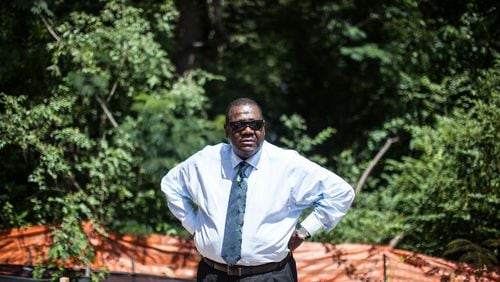Editor’s note: Some improvements have been made at the cemetery.
Hidden in a bustling pocket of Buckhead, surrounded by half-million-dollar town homes being built in the Georgia clay, sits a historic black cemetery, unnoticed and untended.
Soccer moms and joggers, bikers and Ga. 400 motorists rush past the burial ground located less than a mile south of Lenox Square, oblivious to the more than 300 souls resting there, many of them former slaves.
But Richard Thomas and his cousins Audrey Collins and Earl Dillard, they know. They grew up in the Piney Grove Missionary Baptist Church, which once stood there. Most of their ancestors are buried in the Piney Grove Cemetery. So one hot day in June, the three ventured to the graveyard for the first time in years and, fighting mosquitoes, sought their relatives.
What they found shook them. About 10 feet away from an asphalt street that will soon lead to a set of homes, Audrey Collins spotted her grandmother’s headstone. It wasn’t fastened to the ground. Rather, it was leaning gently against a tree.
She could find no headstone at all for her baby brother, Stanley Collins. Or for her grandfather, Joshua Thomas.
Retired Atlanta police officer Richard Thomas — he dared not venture into the weeds — speculated that he was standing on their grandfather’s grave, beneath the hot asphalt. Nearby, still in the woods, Audrey Collins spotted a pile of broken headstones. She refused to look at them, and ran.
“It was heart-wrenching to see your loved ones like that,” Collins said. “You don’t know where they are. You can’t find the markers, and the ones you are able to locate are not attached, so we don’t even know if that is where our grandmother is. And we have no idea where our grandfather is.”
‘Not something that was taken lightly’
When Joshua Thomas died in 1987 at the age of 85, his family buried the proud and dedicated former deacon in the church’s ancient cemetery. They buried him next to his wife, Lenora Powell Thomas, who died in 1965, and a grandson who died in infancy around 1955.
Twenty-eight years later, the cemetery is barely recognizable as a resting place. Noxious weeds choke the land, making it impossible for even those walking in it to spot headstones.
While everyone involved in the nearby construction of the Bluffs at Lenox or familiar with Piney Grove Cemetery agrees that the burial ground is in bad shape, no one believes that any graves have been disturbed or paved over to make way for development.
“We sent somebody to check it out and didn’t find that to be the case,” said Sam Massell, president of the Buckhead Coalition.
“There has absolutely been no building on top of graves,” said Mike Smith, who is developing the Bluffs at Lenox for JBGL Atlanta Development.
“This property was a victim of the big real estate meltdown in ’06. And it went through a hell of a lot of scrutiny because of the graveyard,” Smith said. “This job was under the microscope and it was my job was to make sure we stayed off that property. It was not something that was taken lightly.”
‘Kept wondering where the graveyard was’
Piney Grove’s cemetery dates back to 1826 and is one of nine historic cemeteries in Buckhead in various states of repair or preservation, according to Massell.
It rolls from a hilltop down a tree-covered slope toward Lenox Road near the intersection of Canterbury Road. Piney Grove Missionary Baptist Church was condemned in 1948, and members met under the trees or in friends’ homes until a new church was built in 1950. That church partially collapsed in a storm in the 1990s and the Buckhead Coalition helped pay for its demolition.
Church members continued to be buried there into the 1990s, and as recently as 2006 small orange flags stood visible just above the weeds to mark the presumed sites of about 330 graves that were found by archaeologists commissioned by a former developer. Buckhead was wilderness when the church was formed, and the cemetery has returned to that state.
Smith said when he took over development of the Bluffs at Lenox project about a year and a half ago, he ordered his crews to cordon off the cemetery.
“We never go in there,” Smith said. “My policy has been everybody stays the heck out of there.”
However, Smith said when he took on the project he walked through the cemetery and was dismayed at what he saw. Instead of headstones and orange markers, Smith saw an acre of dense weeds, a perfect site for the trash and tire dump it had become. He also saw that pile of broken and discarded headstones.
“Walking around, I kept wondering where the graveyard was. I didn’t know what to expect,” Smith said.
‘Development is outside of the area’
Massell said his group has been working with the church for years to preserve the burial ground and provide access to it.
The plan for developing around the cemetery at Piney Grove Baptist involved delicate negotiations between the original developer and builder, the city of Atlanta and the Buckhead Coalition.
“When the first group bought it, we got the City Council to adopt an ordinance requiring the construction and maintenance of an access road all the way back to the cemetery,” Massell said. “The new owners are being cooperative of that. If they built on the cemetery, they have violated the law. ”
Garth Peters, who investigated the site for the Buckhead Coalition, said that based on “documented evidence,” which includes survey plats, “we could not find any evidence that could support that grave sites were covered over.”
“Based on what I have seen and the best-known information, the development is outside of the area,” Peters said.
‘Something I shouldn’t be disturbing’
Albert Mitchell, an attorney for Richard Thomas, said he is still doing his “due diligence” by studying deeds and survey plats to determine where bodies might be before issuing a legal opinion.
“But I did see that there has been some disturbance of headstones,” Mitchell said. “Based on (Thomas’) recollection, his grandfather is no longer there. I am concerned about that.”
Once the Bluffs property is finished, Smith said the cemetery will be turned over to the homeowners association, which, under an agreement with the developers, will clean and maintain the graveyard.
“But I still want to get some direction by the city to see how we should do that,” Smith said. “I don’t want to be disturbing something I shouldn’t be disturbing.”
Meanwhile, where is Joshua Thomas?
“I have no idea,” said granddaughter Audrey Collins. She has considered that if the graves were not paved over, they were overtaken by nature or vandals. And she realizes the headstone might be somewhere in that pile of rubble. “I would hate to think that that would have happened. … I just don’t know.”







